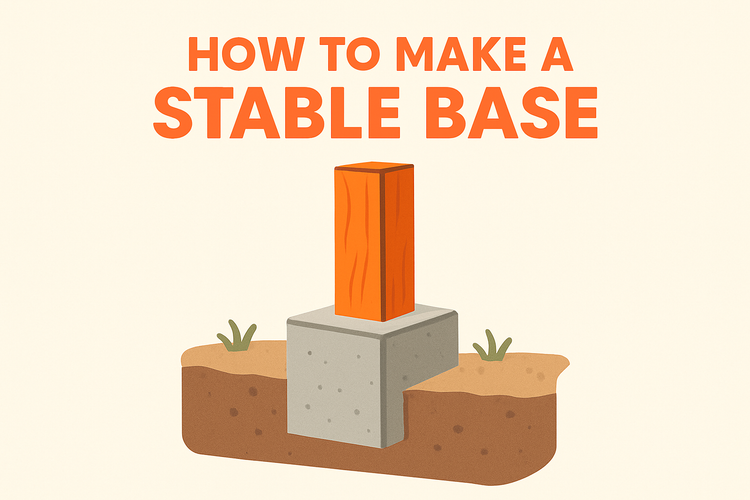How To Make A Stable Base Post

Understanding the Importance of a Stable Base
Every strong structure starts with a well-built base. Whether you're constructing a deck, a fence, or a timber frame building, ensuring stability is non-negotiable.
A stable base serves as the foundation for everything above it, absorbing weight, withstanding environmental forces, and preventing structural shifts. Without it, even the most carefully designed architectures can fail under stress. Whether you're engaging in small-scale DIY projects or large-scale builds, starting with the right base components is key.
Selecting the Right Post Base
The post base acts as the crucial connector between your vertical posts and the ground or slab below, making it an essential part of stability.
Choosing the correct Post Base ensures that loads are properly transferred into the foundation. It's also critical for preventing moisture ingress and reducing the risk of rot in timber posts. Post bases come in various shapes and designs, including adjustable types for uneven surfaces and concealed models for clean aesthetics.
Material choice also matters. Galvanized steel post bases are popular for their durability and resistance to rust. When securing posts for outdoor structures exposed to the elements, opting for high-grade post bases ensures longer structural life and better performance.
Installation should be done meticulously. Anchoring a post base requires compatible fasteners and a flat, stable surface. Using appropriate Screws and nails for secure mounting will help the base maintain its integrity over time. Attention to positioning also plays a role–precision here impacts both strength and aesthetics down the line.
Using Joist Hangers for Enhanced Support
Joist hangers provide essential lateral support for structural timber, helping distribute loads evenly across framing members.
Joist Hangers are especially critical in floor and deck construction. When used correctly, they eliminate the need for notching or end-nailing timbers, which enhances the overall durability and load-bearing capacity. These connectors allow for tight, right-angle connections that minimize movement and reduce the risk of joint failure. They’re ideal for complex framing layouts where precision and strength are needed.
There are several types of joist hangers, including face-mount and top-mounted versions, each suited for different framing scenarios. For installations close to external walls or under exposed conditions, corrosion-resistant finishes such as ZMAX or stainless steel are recommended. Reinforced models are also available for use in high-load or high-wind environments.
To get the most out of a joist hanger, it’s important to use corresponding fasteners that are approved by the manufacturer. Shortcuts here can lead to a compromise in structural performance. For projects like decks or loft conversions, joist hangers paired with strong post bases create a powerful support system that prevents sagging and maintains alignment over time.
Implementing Restraint Straps for Lateral Stability
Restraint straps are often overlooked but play a fundamental role in stabilizing timber structures against lateral forces.
These steel ties anchor roofs, floors, and walls, ensuring they remain interlocked during shifting pressures such as wind, impact, or even seismic movements. Restraint Straps take on significant force, often concealed beneath insulation or timber panels, but their effect is far from invisible. They work behind the scenes to maintain structural unity, aligning components and keeping them from pulling apart.
They’re particularly important in roof systems where uplift forces can literally detach structural elements if not properly anchored. Installed horizontally or vertically, restraint straps provide a robust bridge between framing components and blockwork. They come in varying lengths and hole configurations to match the particular layout of any project. Selection should consider both the span and expected loads, as over- or under-specifying can jeopardize a build’s safety.
When designing any structure expected to face wind loads or movement, integrating restraint straps early in the plan can prevent retrofitting or structural failure. Combined with joist hangers and suitable post base components, these simple but powerful fixes offer long-term peace of mind.
Securing Framing with Screws and Nails
The fasteners you use are as important as the structural components themselves. Screws and nails keep everything locked in place.
Using quality Screws and nails ensures lasting integrity of your connections. While nails offer speed during installation, screws provide superior holding power and are less likely to work loose over time. Different situations call for different options—ring shank nails for resisting withdrawal, or structural screws for deep embedment and load-bearing applications.
It’s not just about choosing between screws or nails—it’s about selecting compatible sizes and materials. Timber frames in exterior environments will benefit from galvanized or coated fasteners to avoid corrosion. For denser timber species, pre-drilling might be necessary to avoid splitting or splitting pressure during driving.
Furthermore, consistency in anchoring depth and alignment helps maintain uniform load distribution, reducing stress concentrations that can cause fatigue. With the right fasteners complementing fixtures like joist hangers and post bases, the overall strength of the structure can be achieved efficiently and safely.
